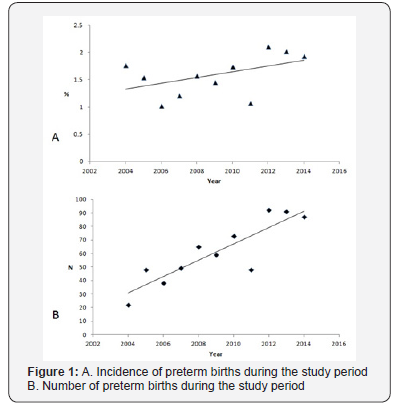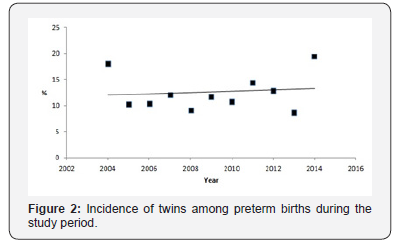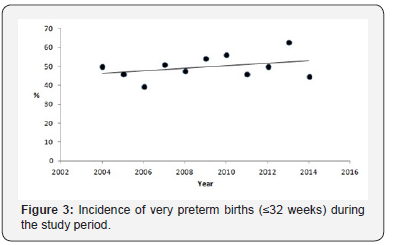Minding the Gap Between Improved Economic Status and Increased Preterm Births: Trends of Preterm Births in A Tertiary Center in Albania-Juniper Publishers
Global Journal of Reproductive
Medicine Juniper
Publishers
Authored by: Isaac Blickstein*
Albania is a developing European country which underwent tremendous political and economical changes in the in the last quarter of a century. At present, Albanian gross domestic product (GDP) ranks 96, the inflation rate is declining, and the GDP growth and GDP per capita are increasing-a measure of a strengthening economy. Whereas the relationship between improving economy and general health is clear, it is unknown how these changes specifically affect the preterm birth rate. A recent publication of the Albanian Institute of Public Health [1] claimed a decreasing estimated neonatal mortality rate from 15/1000 to 11/1000 during the periods 1994-1998 and 2004-2008 respectively. The authors of this document, however, cautioned the reader because of some inherent inaccuracies related to data collection. Even more recently, an international survey included Albania among the developed countries and reported a 2.4% reduced stillbirth rate, although the data were deemed by the authors themselves to be of low quality [2]. A publication issued by the World Health Organization reported, without reference, a preterm birth rate of 9/1000 [3]. This figure should also be considered with caution because for some years, births in Albania were counted only after 28 weeks’ gestation. In order to overcome these caveats and to explore the relationship between improving economy and preterm birth, we used data from a tertiary hospital in Tirana, Albania, to evaluate trends in preterm births during the period 2004-2014.
Materials and Method
The study was conducted at the University Obstetrics and Gynecology Hospital “Koco Gliozheni”, Tirana, Albania. This is one of two tertiary centers caring for a population of roughly 3 million. We identified all liveborn preterm deliveries at ≤34 weeks among the 42161 births between 1.1.2004 and 31.12.2014. Our service provides for the local population as well as for in utero transports from rural areas around Tirana. In our hospital, preterm births are attended by trained obstetrical personnel including the presence of a neonatologist. Decision for a cesarean birth was at the discretion of the attending obstetrician. The retrieved data were entered into a preset Excel file (Microsoft Office 2007, Redmond, WA., USA) without any patient identifier. Thus, the analysis of the anonymous data was exempt of approval by the local Ethical Committee.
We examined annual trends of
I. Incidence of preterm births,
II. The crude number of preterm births,
III. The proportion of twins among all preterm births, and
IV. The incidence of very preterm births (≤32 weeks).
Trendlines were automatically generated by the Excel program, and Pearson’s R2 correlation coefficient was calculated to examine the strength of the association. We also evaluated if the slope (gradient) of the trendline was significantly different than zero (i.e., compared to no change over time); p-value for the difference <0.05 was considered significant.
Results
There were 671 preterm births at less than 35 weeks’ gestation during the study period (1.6%), including 342 births at ≤32 weeks (51.0%). The dataset comprised 84 preterm twin births (38.1%), including 32 births at ≤32 weeks (9.3% of all births at these gestational weeks). The incidence of preterm births was not significantly correlated with the year of birth but nonetheless significantly increased during the study period (Figure 1A), (Pearson’s R2=0.23, p-value for the slope <0.05), within a range between 10 to 21 preterm/1000 births. In contrast, the crude numbers of preterm births both significantly correlated with the year of birth and increased significantly over the years (Figure 1B), (Pearson’s R2=0.77, p-value for the slope <0.05), within a range between 22 to 92 preterm births per year.

The data also showed that the contribution of twins to preterm deliveries was neither correlated with the year of birth nor was it changed over the years (Figure 2), (Pearson’s R2=0.01, p-value for the slope >0.05). Finally, the incidence of births at ≤32 weeks also did not correlate with the year of birth and did not change over the years (Figure 3), (Pearson’s R2=0.11, p-value for the slope >0.05).


Discussion
To the best of our knowledge, this is probably the first report on preterm births in Albania using a validated patient’s chart dataset rather than educated estimates [1-3]. The data indicate that the preterm delivery rate ranged from 10/1000 (in 2006) and 21/1000 (in 2012), for a crude average of 16/1000 – almost twice higher than reported elsewhere [3]. The explanations for this difference might be the different definition of birth (24 weeks in our study as compared to 28 weeks in former reports [3]). Having said this and bearing in mind the role of our hospital as a referral center, we believe that our figures more accurately describe the true incidence of preterm births in Albania. This increased incidence of preterm births was not related to a change in the incidence of preterm twins (Figure 2), a common cause in industrialized countries with a high number of multiple pregnancies following various infertility treatments [4]. Thus, Figure 2 may indicate a relatively low incidence of infertility treatments (as is observed in low to middle income countries) and reflect the stable frequencies of natural twining. Nevertheless, although twins comprise roughly 1% of the entire population, they comprise nearly 40% of the all preterm births and nearly 10% of all birth at ≤32 weeks. This alone reiterates the critical contribution of twins to the number of preterm births (and consequently, the potential associated perinatal morbidity and mortality).
Interestingly, there was no significant change in very preterm births suggesting that the general increased incidence of preterm births is a result of more infants born at 33-34 weeks (Figure 3). Whereas preterm births before 33 weeks may represent the natural frequency of ‘true’ preterm births, later preterm (the so-called near term) births might be related to iatrogenic causes as obstetricians currently feel more comfortable than before to deliver patients at such gestational ages [5]. The most important observation, at least from the public reproductive health perspective, is the significant increase in the total number of preterm births from year to year. The steeper inclination of the slope in Figure 1B as compared to that in Figure 1A and the significant Pearson’s correlation, suggests that more preterm infants are expected each year. The increasing number of premature infants must be matched with increasing number of cribs in the intensive care unit along with additional of appropriately trained neonatal personnel [6].
This study did not discuss management and outcomes of preterm births nor the associated perinatal mortality and morbidity but merely shows that there is an increased incidence of preterm births despite significant improvement of socio-economic status. Joseph et al. [7] described that preterm birth rates were significantly higher among women in the lowest (versus the highest) family income group for spontaneous but not iatrogenic preterm birth. After adjusting for maternal characteristics, the family income-spontaneous preterm birth relationship was attenuated; at the same time, however, the relationship with iatrogenic preterm births became stronger. It is thus likely that the improved socio-economic status in Albania is paradoxically (or not) related to the increased incidence of preterm births. Alternatively, one must consider that the increased incidence of preterm births might be a result of better in utero transports and hence, a potential of inclusion bias.
As this is probably the first attempt to evaluate preterm births in Albania, large and preferably nationwide studies are required to help understand and reduce the gap between improving economical status and increasing preterm births in Albania.
Comments
Post a Comment